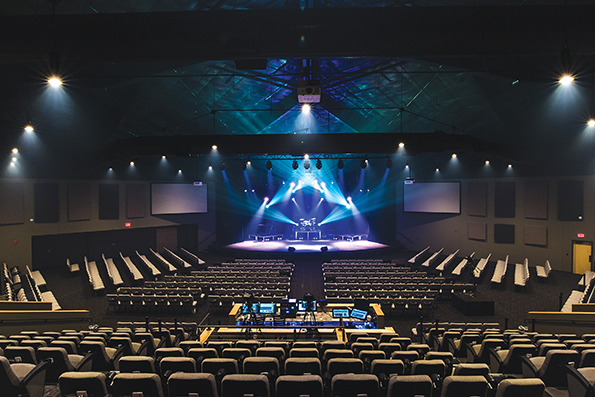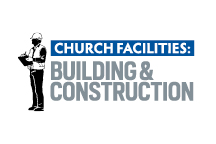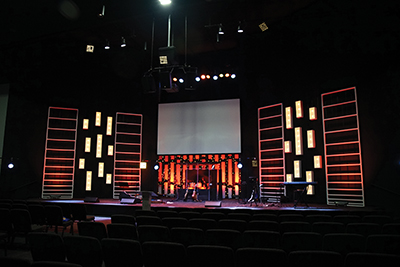
By Rodney James
 Remodeling church facilities can be a painful process — but it doesn’t have to be that way.
Remodeling church facilities can be a painful process — but it doesn’t have to be that way.
If the church takes the right steps (in the right order, with the right partner), a renovation project can flow smoothly, stay on budget, and have a positive effect on the ministries of the church during the process.
Having served as an executive pastor and lead pastor through three major renovation and expansion projects, I understand firsthand how construction can affect church ministries. So, having walked that journey and led many other pastors through that process, let me share some thoughts on how you can prepare your team and your church for a project of your own.
Choose the right partner
This is the first and most critical decision you’ll make about renovating your facilities. You need a designer and builder who have been in your shoes. You can’t expect architectural and construction professionals who haven’t served in ministry to help you plan and coordinate how a project will impact your ministry.
If your partner doesn’t engage conversations about how your ministries can function around the areas of renovation, this should be a red flag. As a church and ministry designer and builder, our first conversations are based on how a church will continue to function throughout the course of construction. Our team understands — and builds into our schedule and communication with subcontractors — even unexpected factors such as funerals and other unplanned ministry needs. Choose a partner to design and build your project who can be a true source of counsel to assist you through the entire journey.
 Construction will impact ministry flow
Construction will impact ministry flow
No matter how large or small a renovation project might seem, it will in some way impact the regular flow of your ministries. However, that impact doesn’t have to be negative, nor should it be. In fact, a good communicator should use this opportunity to lead his or her people through a season of excitement, anticipation, and even growth, both spiritually and numerically.
The way to do this is to stay focused on the future impact of the “results” of the project. Communicate the opportunity for lives to be touched, changed and transformed by the finished product. The project details are important to communicate, but the focus should always remain on the impact of the outcome — not the process.
Budget accuracy (and “wiggle room”) is key
To ensure a successful project, you must insure that your designer is providing you accurate construction costs with plenty of contingency for unexpected issues that arise during demolition and renovation. One of the greatest failures in renovation projects is not having an accurate budget during design.

Designers often use square footage estimates or rely on simple historical data to determine budgets. But, the only way to accurately know what every line item is going to cost is to have real pricing during the design process. You need your builder (and even subcontractors) involved throughout design, putting eyes on the drawings and the existing facility to determine real costs for each aspect of the project.
To design a renovation or expansion project, and then put it out to bid, is asking for sticker shock and a myriad of change orders that will push you over budget during construction. Having successfully completed hundreds of projects under budget, our team knows the absolute value of getting real pricing all through the design process.
Project Profile: Asbury United Methodist Church (Tulsa, OK)
Though the recent remodel of the sanctuary Asbury First United Methodist Church was a major undertaking, the church never missed weekend services or experienced disrupted weekday preschool and ministry events.
Instead, a massive tent was set up each Sunday afternoon to protect the rest of the building from the construction mess. More than 10,000 square feet of plastic was draped from ceiling to floor surrounding the construction area. Specific tents for cutting concrete, demolishing portions of the existing stage, and tearing out sheetrock kept the dust intrusion to a minimum.
The stage expansion took place week by week, with exposed framing and decking, right in front of the congregation. In fact, the imposition was used as an excitement-builder for what the new facility would be when finished.
Moreover, the project was completed with minimal change orders — and 2.5 percent under budget! This kind of outcome is extremely rare
with remodel projects, but the Churches by Daniels team took great care in accurately pricing every step of the project throughout the
design process.Now, the renovation has had major impact on the Sunday morning worship experience. It has also extended the life of the new sanctuary beyond the next decade with minimal impact to the church’s ministries.
Expect the unexpected
Plan for issues and problems. Having participated in multiple renovation projects — from both the ministry and, now, professional construction side — I know firsthand that every project has problems and issues.
Having served on staff during major projects, I coach the church teams we work with on what to expect. Meanwhile, our team gives them great confidence that our job is to find solutions to every issue and problem. When a church has a relationship of complete trust in its building partner, the staff can have peace of mind, even when problems arise. We know the importance of keeping everyone aware of the progress and the process throughout the project; so, if something unexpected happens, everyone is on the same page and has the answers for what’s happening and how we’re going to walk through it.
Renovation and expansion projects keep church facilities up to date and allow for continued growth. Even though the process will interrupt the weekly flow of ministry activity, it doesn’t have to be a painful process.
Rodney James served as executive pastor, then senior pastor, at Sequoyah Hills Baptist Church in Tulsa, Okla., for 20 years. In that time, he led and completed multiple building and renovation projects. In 2012, James joined Churches by Daniels, Inc., in Broken Arrow, Okla., as Director of Business and Finance. He is now a Business Partner and Vice President of Business and Design. The company specializes in designing and building churches nationwide.


